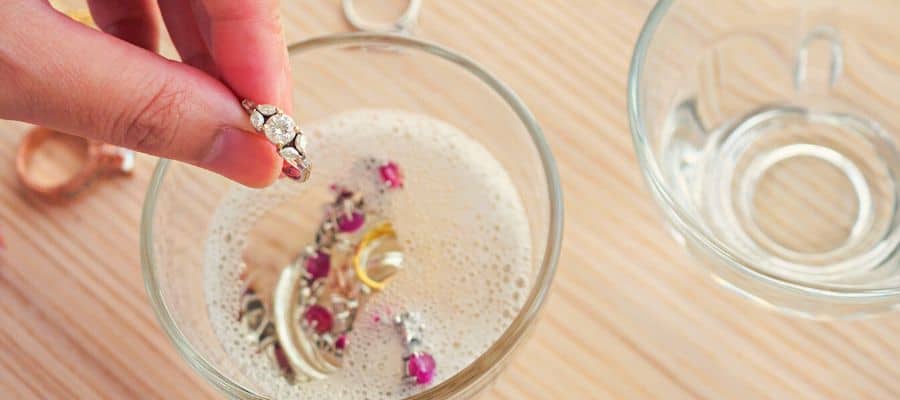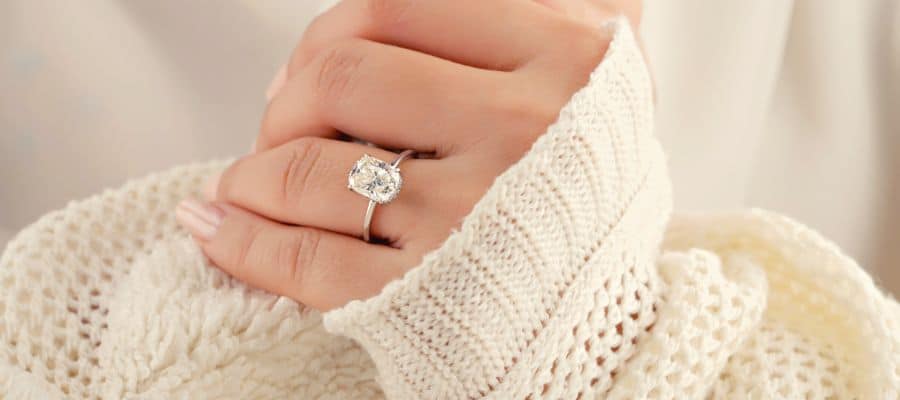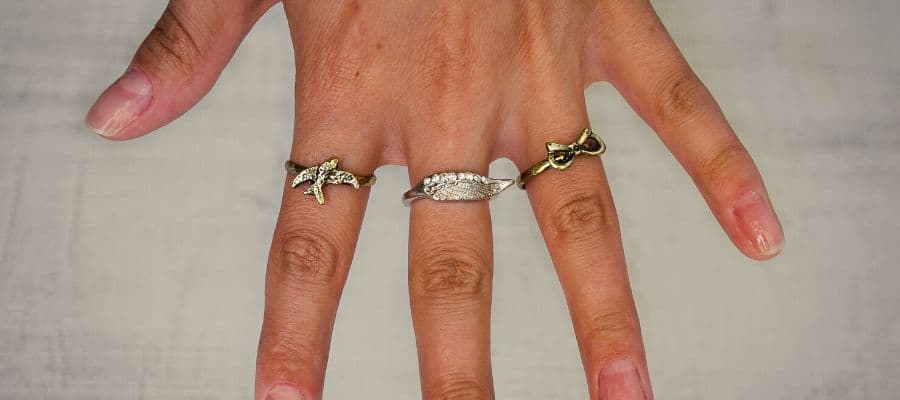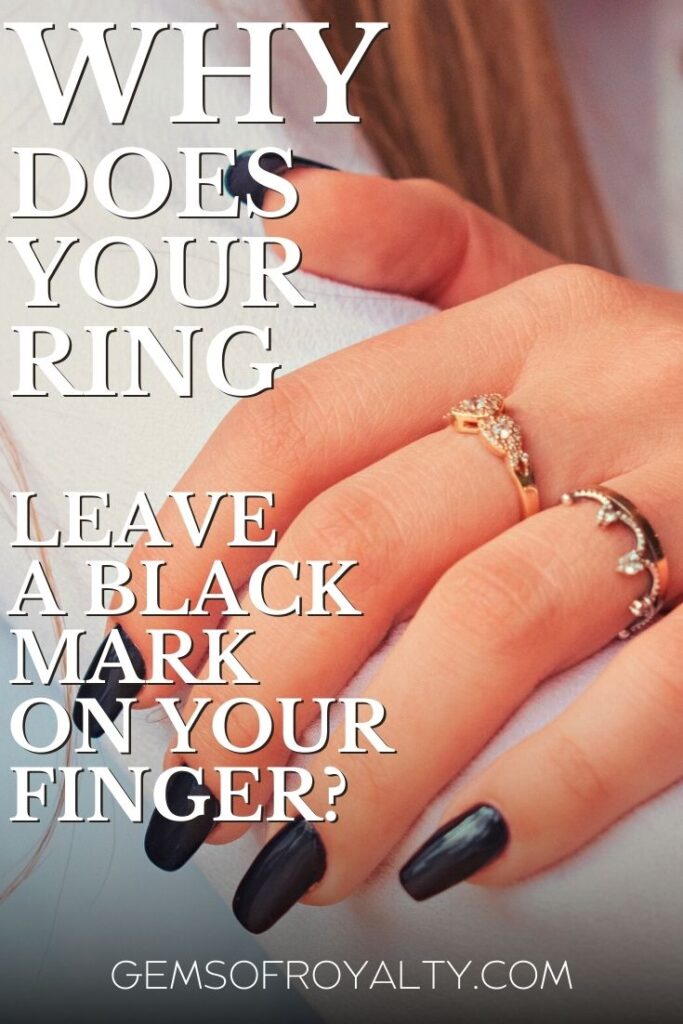Rings are a wonderful symbol of matrimony, status, or aesthetic appeal. However, sometimes rings leave an undesirable black mark on our fingers. Why do rings leave these marks, and how can we prevent this from happening?
Rings leave a black mark on fingers because they react with chemicals on the skin. Precious metals are mixed with alloys that corrode when they come into contact with sweat, chlorine, and other substances. You can prevent black marks by keeping rings clean and applying a veneer inside the ring.
It’s essential that our rings and our fingers remain clean. This article will cover why rings leave black marks, how to prevent them from happening, and how to remove black marks if you receive them.
How To Prevent Black Finger Marks From Your Ring

The first step to keeping your fingers clean is prevention. Black marks arise because of chemical corrosion or abrasion between your skin, the alloys within the ring, and sweat or another chemical.
However, because it takes a while for black marks to become present, you can stay on top of undesirable marks with the following steps.
1. Remove All Rings if Black Marks Are Present
If you already have black marks, remove your rings and clean them thoroughly to remove any chemicals that may be corroding the metal. While cleaning the black spot off your finger may be helpful, it will come back if you don’t properly clean the rings themselves.
2. Clean Your Rings
Rings already corroding need to be cleaned immediately for the best effect. Stopping the corrosion process in its tracks will increase the longevity of the ring and prevent black marks for some time.
Brides.com recommends the following steps to properly clean your ring:
- Fill a bowl with hot soapy water.
- Soak the ring for about 30 minutes.
- Lightly brush the ring with a toothbrush or sponge.
- Dry the ring with a cloth or rag.
While cleaning your ring will help prevent marks in the short term, over time, they will come back. Use these additional steps to prevent black spots from forming on your fingers.
3. Use a Skin Absorbent Powder
Often, our rings come into contact with sweat on our hands. The oils and salts react with the ring’s alloys, causing black marks to form.
One way to prevent black marks is to limit how much sweat contacts the ring. Using a skin-absorbent powder on your hands is helpful on hot or humid days that guarantee sweat. The powder absorbs the sweat and keeps your rings free of abrasion.
However, a best practice is not to use skin products with zinc oxide, which is most commonly in sunscreen but sometimes in absorbent powders. The zinc rubs against the rings, causing slight abrasions which rub off onto your finger and cause black marks.
4. Avoid Hand Creams and Specialty Soaps With Your Ring
Many hand creams and lotions are great for our skin but necessary for our rings. In many cases, the chemicals within lotions or soaps interact with rings and slightly corrode them, leaving black marks.
The best practice is to remove your rings before applying lotion and put them back on when the lotion is fully absorbed.
5. Avoid Chlorine and Other Environmental Corrosives
Certain chemicals don’t react well with the alloys in our rings, and chlorine is no exception. One of the biggest culprits for black marks are pools, hot tubs, and other areas with chlorine.
When swimming or at the spa, remove your rings to prevent contact with chlorine. If your rings come in contact with chlorine, clean them before wearing them again to prevent further corrosion.
6. Apply a Veneer to the Ring
The best way to prevent black marks on your fingers is to apply a surface coating (veneer) to the ring. The veneer will create a barrier between the ring and your finger, preventing abrasion or corrosion.
There are many options for your veneer, depending on the ring in question, its value, and how quickly it leaves a black mark on your fingers.
Something Borrowed recommends the following options, in order of their price:
- Clear nail polish. Nail polish is a quick and easy fix that requires no trips to the store. This method won’t last long; you’ll need to reapply the coat somewhat frequently.
- Jewelry Shield. Similar to nail polish, a jewelry shield is a thin coating designed specifically for jewelry that leaves undesirable marks.
- Spray-on enamel coat. Enamel sprays are an affordable option that works similarly to nail polish or Jewelry Shield but last much longer.
- Rhodium plating. Plating the inside of your ring is the most permanent and costly option. This veneer is best for expensive rings you want to preserve for a long time.
Reasons Why Your Ring Leaves a Black Mark

Once you know how to remove black marks from your fingers and prevent them from happening, it’s helpful to understand why rings leave those marks in the first place. Knowing why rings leave marks can help you plan for when you purchase or receive new rings.
Fine rings are made with precious metals, such as gold, and platinum, mixed with metal alloys. The proportion of precious metals in jewelry is known as their karat value, with pure precious metals having 24 karats (24k).
All jewelry has some proportion of alloys. Alloys can include the following metals:
- Copper
- Silver
- Nickel
- Zinc
- Cobalt
- Palladium
Generally, black marks are caused by reactions with the alloys in a ring, not the precious metals. While precious metals don’t react with the skin, they are far too soft and malleable to be crafted by themselves. Precious metals are mixed with harder metals to keep their shape.
Rings with a higher proportion of alloys than gold cause more skin irritation than higher karat jewelry. Let’s evaluate why the alloys in your ring leave black marks.
The Ring Is Reacting to Chemicals
When a ring leaves black marks, a chemical reaction occurs between a component on the skin and the alloys within the ring. These reactions can be either chemical abrasion (rubbing) or corrosion (deterioration).
Chemical Abrasion
Chemical abrasion is the process of substances rubbing against the alloys of a ring, slowly flaking off metal specks. The flakes produced oxidize against your skin, creating a black color.
Abrasion is most common with lotions and soaps containing tiny particles that constantly rub against the inner lining of the ring. The most common example is sunscreens with zinc oxide that rubs against your ring during the summer.
Chemical Corrosion
Corrosion is the process of metal slowly dissolving. The byproduct of corrosion on your ring is the black specs that make a mark on your finger. Corrosion is most common in humid conditions with salt or in the presence of chlorine.
Because chlorine and humidity are highly present in swimming pools, spas, and hot tubs, it’s a good practice to remove your rings before entering these areas. Alternatively, you can clean your rings after spending time in chlorinated water.
Chemicals such as byproducts in lotions can also react with ring alloys and begin to break them down. Further, corrosion is slightly more irritating and noticeable than abrasion and is more commonly the cause of black ring marks.
The Ring Is Reacting to Your Sweat
For rings with a high proportion of alloys, sweat can make a big difference. Sweat contains salt, oils, and acids that slowly wear away at your ring. While sweating hands is natural, especially on hot days, it can lead to black marks on your fingers over time.
If sweat is an issue, consider a skin-absorbent powder (without zinc oxide), or take your rings off during hot or humid days.
The Ring Is Reacting to Humidity or Salt
Often, it’s environmental conditions that contribute to the black marks on our fingers. Salt is particularly corrosive to rings, and moisture, in general, speeds up the process.
When in humid or salty environments, such as on a beach, it’s best to be mindful of the environmental conditions and plan accordingly. In some cases, it may be helpful to remove your rings to prevent black marks from forming.
You’re Allergic to One of the Ring’s Alloys
It’s possible that black marks are forming because you’re allergic to one of the alloys in the ring. In these situations, the black spot will be less of a passive process and far more irritating than standard ring marks.
You may be allergic if you’re getting significant inflammation in addition to black marks. In these situations, contact a licensed medical professional to diagnose the allergy and determine a more suitable alloy for your ring.
The Ring Has a High Percentage of Alloys
Because a ring’s alloys cause reactions, rings with a lower karat value may be more irritating than more valuable ones. However, higher karat rings are significantly more costly than their alternatives.
If it’s cost-effective, consider wearing rings of a higher karat value. These rings will cause less irritation, leave fewer marks, and remain a solid financial asset for as long as you keep them.
How To Remove Black Rings on Your Fingers

Sometimes it can be challenging to stay on top of jewelry maintenance, and inevitably black marks arise. Alternatively, you could already have black spots on your fingers that you want to eliminate.
Either way, removing black marks from your fingers is quick and easy with the proper steps. In most cases, you can use household items to do away with black marks. Or, consider getting a professional manicure, so you don’t have to worry about a thing.
Use Lemon and Honey
The most natural and efficient home remedy is lemon and honey for the affected areas. All you need are a tablespoon of honey and the juice of one lemon.
Boldsky recommends the following steps for removing ring marks:
- Combine honey and lemon juice in a bowl.
- Apply to the skin on and around the black marks.
- Leave the mixture on your skin for 15 minutes.
- Wash away the mixture.
- Repeat 2-3 times a week if the problem persists.
The lemon juice helps to remove the alloy filaments causing black marks, while the honey provides the right consistency for the mixture to be effective.
Use a Moisturizer
Many herbal lotions and moisturizers can help remove black marks, provided you wash away the moisturizer when you’re finished. The best options are herbal moisturizers, such as aloe vera, that will rub against the black mark and slowly wear it away.
As a bonus, moisturizers protect your skin from drying out, which can contribute to the black marks on your fingers. Dry skin is more likely to rub against the inner lining of the ring and cause abrasions to the metal alloys.
Get a Manicure
If you don’t feel like removing the black marks yourself, you can always have a professional nail technician manicure your fingers. Nail technicians or manicurists have all the tools available to quickly and efficiently return your fingers to a pristine state.
Additionally, nail technicians can provide a full suite of manicure services. Not only will they remove stubborn black marks, but they will also clean your fingers, stylize your nails, and ensure all your needs are taken care of.
For the best investment, consider removing the black marks when you schedule your next manicure appointment. Nail technicians are also excellent resources for the best moisturizers, lotions, and remedies to prevent and remove black marks caused by rings.
Final Thoughts
Rings are valuable symbols for those who wear them. However, the presence of certain alloys within rings can also cause undesirable black marks to form on our fingers.
Black marks form from chemical reactions between the inner lining of the ring and substances on our fingers. The reactions happen specifically with the alloys of the ring, and lower karat rings will cause more irritation.
You can prevent black marks by creating a veneer on the inner lining of your rings, cleaning your rings, and avoiding caustic chemicals such as chlorine.
If you found this article useful, make sure you save this pin below to your Jewelry board.


